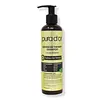What's inside
What's inside
 Key Ingredients
Key Ingredients

 Benefits
Benefits

 Concerns
Concerns

 Ingredients Side-by-side
Ingredients Side-by-side

Water
Skin ConditioningSodium Laureth Sulfate
CleansingSodium Lauryl Sulfate
CleansingCocamidopropyl Betaine
CleansingCaffeine
Skin ConditioningSandalore
Sodium Benzoate
MaskingCitric Acid
BufferingMentha Arvensis Leaf Oil
MaskingPanthenol
Skin ConditioningSalicylic Acid
MaskingLauric Acid
CleansingNiacinamide
SmoothingTrisodium Ethylenediamine Disuccinate
Methylparaben
PreservativePolyquaternium-10
Mentha Piperita Oil
MaskingSodium Hydroxide
BufferingLimonene
PerfumingBiotin
AntiseborrhoeicAlcohol
AntimicrobialTocopherol
AntioxidantSodium Citrate
BufferingSodium Chloride
MaskingSodium Xylenesulfonate
Water, Sodium Laureth Sulfate, Sodium Lauryl Sulfate, Cocamidopropyl Betaine, Caffeine, Sandalore, Sodium Benzoate, Citric Acid, Mentha Arvensis Leaf Oil, Panthenol, Salicylic Acid, Lauric Acid, Niacinamide, Trisodium Ethylenediamine Disuccinate, Methylparaben, Polyquaternium-10, Mentha Piperita Oil, Sodium Hydroxide, Limonene, Biotin, Alcohol, Tocopherol, Sodium Citrate, Sodium Chloride, Sodium Xylenesulfonate
Aloe Barbadensis Leaf Juice
Skin ConditioningCocamidopropyl Hydroxysultaine
CleansingPolyquaternium-71
HumectantPolyquaternium-73
Sodium Hydroxide
BufferingSodium Cocoyl Glutamate
CleansingLactobacillus Ferment
Skin ConditioningSalix Alba Bark Extract
AstringentMelaleuca Alternifolia Leaf Oil
AntioxidantArgania Spinosa Kernel Oil
EmollientNigella Sativa Seed Oil
EmollientUrtica Dioica Leaf Extract
Skin ConditioningGrateloupia Elliptica Extract
Skin ConditioningBiotin
AntiseborrhoeicSerenoa Serrulata Fruit Extract
Skin ConditioningCedrus Atlantica Bark Oil
MaskingRosmarinus Officinalis Leaf Oil
MaskingSalvia Sclarea Oil
MaskingPolygonum Multiflorum Root Extract
Skin ConditioningHibiscus Sabdariffa Flower Extract
Skin ConditioningPrunus Africana Bark Extract
Skin ConditioningCucurbita Pepo Seed Oil
EmollientCamellia Sinensis Leaf Extract
AntimicrobialZinc Pyrithione
AntiseborrhoeicSoy Isoflavones
Skin ConditioningBeta-Sitosterol
Emulsion StabilisingEmblica Officinalis Fruit
Skin ConditioningCitrus Limon Peel Oil
MaskingCitrus Grandis Seed Extract
AstringentCymbopogon Flexuosus Oil
MaskingRicinus Communis Seed Oil
MaskingNiacin
SmoothingTocopherol
AntioxidantSorbitan Oleate Decylglucoside Crosspolymer
CleansingXylityl Sesquicaprylate
AntimicrobialCitric Acid
BufferingAloe Barbadensis Leaf Juice, Cocamidopropyl Hydroxysultaine, Polyquaternium-71, Polyquaternium-73, Sodium Hydroxide, Sodium Cocoyl Glutamate, Lactobacillus Ferment, Salix Alba Bark Extract, Melaleuca Alternifolia Leaf Oil, Argania Spinosa Kernel Oil, Nigella Sativa Seed Oil, Urtica Dioica Leaf Extract, Grateloupia Elliptica Extract, Biotin, Serenoa Serrulata Fruit Extract, Cedrus Atlantica Bark Oil, Rosmarinus Officinalis Leaf Oil, Salvia Sclarea Oil, Polygonum Multiflorum Root Extract, Hibiscus Sabdariffa Flower Extract, Prunus Africana Bark Extract, Cucurbita Pepo Seed Oil, Camellia Sinensis Leaf Extract, Zinc Pyrithione, Soy Isoflavones, Beta-Sitosterol, Emblica Officinalis Fruit, Citrus Limon Peel Oil, Citrus Grandis Seed Extract, Cymbopogon Flexuosus Oil, Ricinus Communis Seed Oil, Niacin, Tocopherol, Sorbitan Oleate Decylglucoside Crosspolymer, Xylityl Sesquicaprylate, Citric Acid
 Reviews
Reviews

Ingredients Explained
These ingredients are found in both products.
Ingredients higher up in an ingredient list are typically present in a larger amount.
Biotin is a B vitamin that is naturally produced by our bodies. It is also called Vitamin H.
Our bodies use biotin in the metabolism process. It also helps our bodies use enzymes and move nutrients around. A biotin deficiency can lead to brittle hair and nails.
More research is needed on applying biotin topically. However, taking biotin orally has been shown to help nourish the skin, hair, and nails. They play a role in forming skin-hydrating fatty acids.
Biotin is water-soluble. It can be found in foods such as fish, eggs, dairy, nuts, and meat. Vitamin H stands for "haar" and "haut". These are the German words for hair and skin.
Learn more about BiotinCitric Acid is an alpha hydroxy acid (AHA) naturally found in citrus fruits like oranges, lemons, and limes.
Like other AHAs, citric acid can exfoliate skin by breaking down the bonds that hold dead skin cells together. This helps reveal smoother and brighter skin underneath.
However, this exfoliating effect only happens at high concentrations (20%) which can be hard to find in cosmetic products.
Due to this, citric acid is usually included in small amounts as a pH adjuster. This helps keep products slightly more acidic and compatible with skin's natural pH.
In skincare formulas, citric acid can:
While it can provide some skin benefits, research shows lactic acid and glycolic acid are generally more effective and less irritating exfoliants.
Most citric acid used in skincare today is made by fermenting sugars (usually from molasses). This synthetic version is identical to the natural citrus form but easier to stabilize and use in formulations.
Read more about some other popular AHA's here:
Learn more about Citric AcidSodium Hydroxide is also known as lye or caustic soda. It is used to adjust the pH of products; many ingredients require a specific pH to be effective.
In small amounts, sodium hydroxide is considered safe to use. However, large amounts may cause chemical burns due to its high alkaline.
Your skin has a natural pH and acid mantle. This acid mantle helps prevent harmful bacteria from breaking through. The acid mantle also helps keep your skin hydrated.
"Alkaline" refers to a high pH level. A low pH level would be considered acidic.
Learn more about Sodium HydroxideTocopherol (also known as Vitamin E) is a common antioxidant used to help protect the skin from free-radicals and strengthen the skin barrier. It's also fat soluble - this means our skin is great at absorbing it.
Vitamin E also helps keep your natural skin lipids healthy. Your lipid skin barrier naturally consists of lipids, ceramides, and fatty acids. Vitamin E offers extra protection for your skin’s lipid barrier, keeping your skin healthy and nourished.
Another benefit is a bit of UV protection. Vitamin E helps reduce the damage caused by UVB rays. (It should not replace your sunscreen). Combining it with Vitamin C can decrease sunburned cells and hyperpigmentation after UV exposure.
You might have noticed Vitamin E + C often paired together. This is because it is great at stabilizing Vitamin C. Using the two together helps increase the effectiveness of both ingredients.
There are often claims that Vitamin E can reduce/prevent scarring, but these claims haven't been confirmed by scientific research.
Learn more about Tocopherol